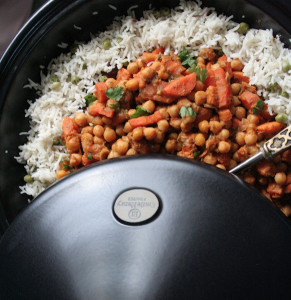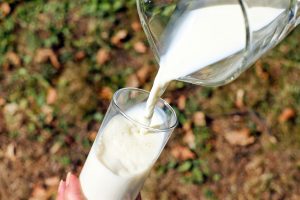Gluten-free for kids: Christine Bailey shows us how to keep the little ones healthy and happy without making unpopular food sacrifices…
It can be difficult enough encouraging your children to eat a nutrient-rich diet, but if your child is coeliac or suffering with gluten sensitivity, switching to a gluten-free diet can bring with it additional concerns.

As the organiser of the Free From Awards Children’s category, and a nutritionist and mother of gluten-free children, I have plenty of experience working with and supporting children and their families with allergies.
In addition to nutritional concerns, there are many emotional and social factors to consider. Whether it’s eating at school, nursery, eating out with family and friends, attending children’s parties or days out, following a gluten-free diet can feel overwhelming and socially isolating.
Even without having to follow a specific diet, national dietary surveys indicate that many children and teenagers miss out on valuable nutrients. Similarly, only 10% of boys and 7% of girls met the recommended five-a-day. Teenagers require high amounts of bone nutrients including calcium, vitamin D and phosphorous. In addition, during adolescence, there is an increased need for various nutrients including zinc, iron, folate and B12 – many of which can be lower in coeliacs.

Gluten-free diet
A gluten-free diet involves the complete avoidance of all foods made from or containing wheat, rye and barley. Removing gluten grains from the diet could potentially mean missing out on certain nutrients. Wheat, barley and rye, especially in their unprocessed form, are rich in vitamins and minerals including zinc, magnesium, manganese, copper and selenium and provide plenty of fibre.
This is particularly relevant if your child has recently been diagnosed with coeliac disease. Key nutrients that have been shown to be low in newly diagnosed coeliacs include folic acid, vitamin B12, vitamin E, selenium, iron, calcium and vitamin D.
One of the benefits of following a gluten-free diet is that it encourages you to rethink your eating and shopping habits. The easiest way to ensure your child’s diet is healthy is to focus meals on natural whole foods.
For each meal, include a palm-sized portion of protein (meat, fish, eggs, beans, pulses etc) with a wide selection of colourful vegetables and either some starchy vegetables (butternut squash, carrot, beetroot, sweet potato) or some unprocessed gluten-free grains. Many naturally gluten-free grains are incredibly nutritious – quinoa, amaranth, buckwheat, teff, millet and wholegrain rice, for example, are all rich in essential vitamins, minerals and fibre.

Keep it natural
One of the temptations when short of time or new to a gluten-free diet is to rely too heavily on processed gluten-free products. Many gluten-free versions of staple foods often contain more calories, more fat, more sugar, and more sodium than their glutenous counterparts. These alternative products also typically lack the key vitamins and minerals and fibre found in many gluten-containing products.
While many brands are now focusing more on fortification to match regular versions, they can still lack the full array of nutrients and fibre wholegrains contain. This is important particularly if you are newly diagnosed. Some studies have found that 67% of patients with overt coeliac disease and 31% of those with a silent or subclinical case had malnutrition at the time of diagnosis. Simply switching to a gluten-free diet may therefore not be sufficient to restore depleted nutrients.

Iron deficiency anaemia can be common following a diagnosis of coeliac disease. In some cases, an iron supplement may be prescribed. As iron is crucial for children’s growth and development, it’s also worth ensuring their diet contains a range of iron-rich foods daily.
Good sources include lean meats, chickpeas, lentils, sesame seeds, spinach, Swiss chard, kale, broccoli, asparagus, liver, tofu, olives, certain seafood, blackstrap molasses, quinoa, dried figs and apricots. Include some vitamin C rich foods (red pepper, leafy greens, fresh fruit etc) with meals as this aids iron absorption.
Fibre is another essential nutrient we all need. Many people fall short of obtaining a sufficient amount of fibre and switching to a gluten-free diet can further reduce overall intake. Fibre not only supports digestive health it also feeds our microbiome, the beneficial bacteria in our gut. Our friendly bacteria play an important role in supporting digestion, the production of certain vitamins, short-chain fatty acids and maintaining a healthy immune system.
Various studies have shown that changes can occur in the type and number of friendly bacteria present in the digestive system following a gluten-free diet. Fermented foods such as raw sauerkraut, kimchi, kefir, kombucha and yoghurt all provide these beneficial bacteria so try and include these regularly – whether as smoothies, desserts or as a side dish to a main meal. If you are dairy intolerant try coconut kefir, coconut yoghurt, almond or cashew nut yoghurt.
Trial and error
To boost your child’s fibre intake, sneak in more beans and pulses or use products made from them like chickpea crisps, pasta and breads. Add ground- up seeds to homemade breads and muffins and experiment with grains like quinoa, millet, buckwheat, wholegrain rice or cauliflower rice.
Bone development is rapid during early teens and, because bone disorders are more common in people with coeliac disease, it’s worth checking your child’s diet is rich in bone supporting nutrients. Damage to the small intestine can affect vitamin D and calcium absorption, but may also influence other fat-soluble nutrients such as vitamin K – involved in bone health. For healthy bones, your body needs a wide range of nutrients in addition to calcium including vitamin D, magnesium, vitamin K, boron, silicon, vitamin C, zinc and protein.
Many of these nutrients are abundant in gluten-free grains like whole grain rice, buckwheat and quinoa as well as leafy green vegetables, nuts and seeds. The best source of vitamin D is sunlight, although you can find some in oily fish, full-fat milk and milk alternatives, egg yolks and mushrooms.

Dairy intolerant?
If you also avoid dairy there are many good calcium-rich alternatives. Depending on the age of your child the recommended intake varies from 350mg to 1000mg. The daily guidelines for adults with coeliac disease are 1000- 1500mg. You can obtain this through a range of non-dairy foods.
Each of the below will provide you with about 250mg of calcium.
→ A glass of calcium-enriched soy milk, rice milk or almond milk (200ml)
→ One small pot of fortified dairy-free yoghurt (150g)
→ Four small sardines, tinned with bones (60g)
→ Small piece of plain tofu (50g)
→ 2 slices of gluten-free bread
→ 60g Tahini (sesame seed paste)
Other good sources of calcium include dried figs, broccoli, spinach, kale, baked beans, kidney beans, sesame seeds and oranges.
Get Label Savvy. The sugar-free label is just as relevant to free-from foods. Thankfully there are brands ditching the sugars and syrups or switching to lower glycemic sweeteners like stevia, Lo han or sugar polyols erythritol and xylitol.
 Christine Bailey
Christine Bailey
Award-winning nutritionist, chef, author and product development expert, Christine Bailey is a well- known consultant in the food and health industry as well as appearing on TV and in the media as an expert in food, nutrition and fitness.
To find out more about Christine, visit www.christinebailey.co.uk
